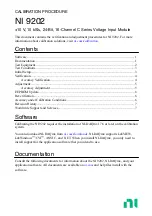
Chapter Two
2 - 2
Using a ASCO Load Bank Safely
Your safety, and the safety of those around you, is dependent on your knowledge of this
equipment’s safe operating procedures. Load banks can be dangerous and must not be
used by unskilled personnel, or by those who have not familiarized themselves with these
instructions.
You should remain alert to potential danger during transport and setup, when the unit is in
operation, and when maintenance operations are performed.
There are four main sources of danger:
Handling hazards.
Load banks are large, heavy devices and they often have to be
manoeuvred in to tight, difficult spaces before they can be setup.
Contact with high voltage electricity.
Serious injury or death could result from contact
with electrically live parts. Even though the connections to the load bank may be temporary,
they must always be made to the same standards as if they were permanent.
Contact with fast moving parts.
The fan, in particular, can cause serious injury if you
come into contact with it when it is in operation.
Heat hazards.
When a test is in progress the resistive elements can glow cherry red. The
heat they produce is removed by the air that the fan forces past them, but that air in turn
can become very hot.
To avoid these hazards, pay particular attention to the following points:
•
Make use of the correct handling equipment and ensure that all personnel involved
in transportation and setup have the appropriate training and experience needed to
carry out the operation safely.
•
Only operate the load bank with the covers and protective screens securely in position.
•
Make sure that both the Supply-on-Test and the load bank are adequately grounded.
•
Ensure all cables are in good condition and adequately rated for the planned load, and
that all connections are securely made.
•
Ensure all cables are long enough to lay in smooth curves, and are unstressed,
undamaged, and protected from mechanical damage.
•
Lay the cables to minimise the risk of personnel tripping or accidentally tugging on
the cables.
•
Keep all personnel who are not directly involved with tests well away from the load
bank and the equipment under test.
•
The discharge air from the load bank can cause serious burns. Keep away from the
outlet grille while the load bank is running, and do not touch it for at least 10 minutes
after the test is completed.
•
Do not switch off the cooling fans immediately on concluding a test. After removing
the load allow the fans to run for a further 3 minutes to dissipate the residual heat. This
will reduce any fire risk and prevent possible damage to the equipment.
•
Make sure that the air inlet and outlets are completely unobstructed and that there is
no loose material that could be drawn in to the air inlet grille.
•
Ensure that there are no combustible material near the air discharge.
•
Keep an approved electrical fire extinguisher present at all times when the load bank
is in operation.
Load Bank Setup
2 - 3












































